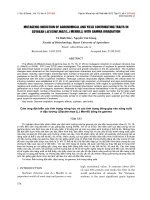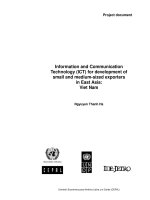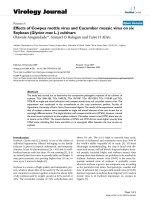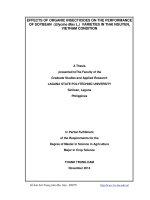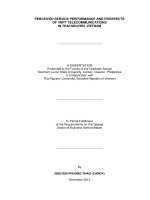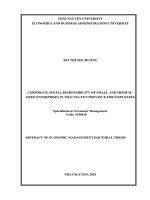Effects of organic insecticides on the performance of soybean (Glycine Max L.) varieties in Thai Nguyen, Viet Nam condition
Bạn đang xem bản rút gọn của tài liệu. Xem và tải ngay bản đầy đủ của tài liệu tại đây (2.13 MB, 118 trang )
EFFECTS OF ORGANIC INSECTICIDES ON THE PERFORMANCE
OF SOYBEAN (Glycine Max L.) VARIETIES IN THAI NGUYEN,
VIETNAM CONDITION
A Thesis
presented toThe Faculty of the
Graduate Studies and Applied Research
LAGUNA STATE POLYTECHNIC UNIVERSITY
Siniloan, Laguna
Philippines
In Partial Fulfillment
of the Requirements for the
Degree of Master in Science in Agriculture
Major in Crop Science
THANH TRUNG DAM
November 2014
Số hóa bởi Trung tâm Học liệu - ĐHTN
/>
i
ACKNOWLEDGEMENT
The author would like to express her heartfelt and warmest gratitude to the
following persons who gave their valuable suggestions, immeasurable support,
and for the strength and inspiration to finish this study.
Dr. Nestor M. De Vera, University President, for his valuable ideas,
comments, and suggestions for the improvement of this study.
Dr. Lolita L. Beato, Dean of College of Agriculture and Adviser, for her
guidance, motivation, valuable ideas and suggestions to make this study
complete.
Dr. Robert C. Agatep, Statistician, for the encouragement, patience and
for helping her on the analysis and interpretation of data.
Dr. Carlos J. Andam, Subject Specialist, for his brilliant ideas, comments
and suggestions for the improvement of this study.
Prof. Lydia R. Chavez, Technical Editor, for her comments and
suggestions on the technical aspect of this study.
Thanks to the farmers for lending his land area for the conduct of this study.
Lastly, the author would like to thank his parents who always love,
comfort, encourage and support in everything he needs to complete this study.
THANH TRUNG DAM
Số hóa bởi Trung tâm Học liệu - ĐHTN
/>
ii
ABSTRACT
DAM THANH TRUNG, Laguna State Polytechnic University, Siniloan,
Laguna. NOVEMBER 2014. “EFFECTS OF ORGANIC INSECTICIDES ON
GROWTH AND YIELD OF SOYBEAN (Glycine Max L.) VARIETIES IN THAI
NGUYEN CONDITION, VIETNAM”. Adviser: Dr. Lolita L. Beato
This research was conducted in Vietnam from June to October 2014 to
determine the growth and yield performance of three varieties of soybeans using
different sources of insecticides under Thai Nguyen condition in Vietnam.
Specifically, the study sought answers to the following questions: what are the
significant differences among the performance of three varieties of soybeans?;
which variety and insecticide sources or their combination will give better growth
performance of soybeans in terms of plant height at maturity, number of days
from transplanting
to flowering, fruiting and harvesting and number of
branches?; which variety and insecticide sources
will give better yield
performance of soybeans in terms of number of pods per plant, length and
weight of pods per plant; weight of soybean seeds and yield per hectare?; which
variety and insecticide sources will give lower number and percentage of
infestation of soybean plants in terms of kinds of insects at different stages of
plant and percentage of infestation a different stages of soybean plant?; are
there significant interaction effects between and or among soybean varieties and
sources of insecticides?; which variety of soybean and insecticide sources or
their combination will be most suitable and economical to use in Thai Nguyen
condition in Vietnam?
Số hóa bởi Trung tâm Học liệu - ĐHTN
/>
iii
A 3x5 factorial experiment in a Randomized Complete Block design
(RCBD) was used in the study with three finger pepper varieties ( A1- DT22, A2DT26 and A3- DT51 variety) and five sources of insecticides B1- control, B2- 50L
hoban 30EC /ha, B3- 50L hocsinh/ha, B4- 50L thaomo/ha and B5- 50L hattao/ha.
Each treatment was replicated four times. Duncans’ Multiple Range Test (DMRT)
was used to determine the significant differences between variety and fertilizer
means.
Result showed that the growth and yield performance of soybean plants
were affected by varieties in terms of plant height, number of days from
transplanting to flowering to fruiting, number of branches, length and weight of
pods. Among the three varieties of soybean plants, DT 22 showed better growth
and yield performance.
Insect infestation of soybean plant is affected by the insecticides applied
at fruiting stage. The yield and economic performance of soybean plants were
affected by varieties and insecticides in terms of number of pods, weight of
soybean seeds, yield per hectare, net income and return on expenses.
Interaction effect was present in insect infestation at vegetative and
flowering stage of soybean plants. Insect infestation is lower at the application of
organic insecticide.
Total sale, net income and return on expense of soybeans increased at
the application of insecticide with the rate of 50L hocsinh/ha.
Số hóa bởi Trung tâm Học liệu - ĐHTN
/>
iv
Since the growth, yield and economic performance of soybeans were
significantly affected by varieties and fertilizer in terms of plant height, number of
days from transplanting to flowering to fruiting, number of branches, length and
weight of pods, number of pods per plant, weight of soybean seeds, yield per
hectare, net income and return on expenses, the use of DT 22 variety and
application of organic insecticide Hocsinc (chilli, garlic, corn bran and egg shell)
at the rate of 50L/ha is being recommended.
Replication of the same study in other areas and field is also
recommended.
Số hóa bởi Trung tâm Học liệu - ĐHTN
/>
1
Chapter 1
THE PROBLEM AND ITS BACKGROUND
Introduction
Soybean (Glycine max L.) is the most valuable grain legume and the third
crop in importance after rice (Oryza sativa) and corn (Zea mays L.) in Vietnam. It
is a rich source of oil and protein. It is also processed into popular products in
Vietnam such as soya-cheese, soya-cake, soya-milk, and cooking oil.In Vietnam,
soybean is grown in about 130,000 ha, of which 42,000 ha (33%) is grown in the
south of the country, consisting of the Eastern region and the Mekong Delta (Yen
Thao, 2004).
Vegetable soybean is rich in phytochemicals beneficial to the human
being and is therefore considered a neutraceutical or a functional food crop.
Edamame (vegetable soy bean) is well established legume in the human diet in
Asia . The positive health benefits of soy have greatly increased consumer
awareness of soy products and created a market potential for soy products
(Beckman, 1997).
Imports of soybeans in 2011 rose significantly due to the increased
demand from the food processing, livestock, and aquaculture feed industries,
and the vegetable oil industry combined with a zero percent import tariff.
Vietnam’s soybean imports reached a record in 2011, surpassing one million
metric tons (MMT). This represents a 350 percent increase over the previous
year; 22 percent of the total imported volume was sourced from the United
Số hóa bởi Trung tâm Học liệu - ĐHTN
/>
2
States. Post expects imports of full-fat soybeans to steadily increase in the next
three to five years. Soybean meal imports increased to a record 3.0 MMT to meet
the growing demand from the livestock, and aquaculture feed sectors (Nguyen,
2012).
Demand for imported soybean meal is forecast to fall as new processing
facilities come on-line in Vietnam. Already, we have seen a sharp increase in
soybean imports in preparation for the opening of the first of two processing
plants. Meal production is expected to grow through the latter-half of 2011 and
attain peakproduction the following year. The full impact on meal imports will be
felt in 2012 with an anticipated reduction in trade around 20 percent. This figure
would be lower if not for continued growth in meal demand driven by expansion
in the pork, poultry and aquaculture sectors. Although initial soybean sales have
comepredominately from South America, there remains opportunity for future
growth in U.S. sales to the region (United States Department of Agricuture,
2011).
In 2012, U.S. soybean exports to Vietnam reached a record of 461
thousand metric tons (TMT), double the 2011 level due to high demand from the
two commercial oilseed crushing facilities, and from the food industry. In 2013,
U.S. soybean exports are expected to reach about 500 TMT. In 2012, Vietnam’s
soybean meal (SBM) imports were 2.5 million metric tons (MMT). Post forecasts
2013 and 2014 SBM imports to gradually decrease due, to 2.4 and 2.37 MMT,
respectively, due to local production. Local soy oil production and exports have
Số hóa bởi Trung tâm Học liệu - ĐHTN
/>
3
been increasing in recent years as results of larger crush and greater oil
availability. Soy oil exports are projected at 110 TMT and 120 TMT in 2013 and
2014, accordingly (Nguyen, 2012).
Productivity of soybeans in Asia, and particularly Vietnam, is low
compared with elsewhere in the world. Vietnam’s average yields are 1t/ha
compared with 1.3 t/ha in Thailand, 1.75 t/ha in Brazil and 2.25 t/ha in the USA.
This low productivity is a problem because Vietnam needs more soybeans to
satisfy a growing demand for stock feed and to improve the nutrition of the
human population. The reasons for poor production in Vietnam have been clearly
identified. One of the most significant is the fact that the varieties grown in
summer have a growing period too short to produce the maximum yield possible
for the season. Moreover, soybean is invariably treated as secondary to rice, and
so receives less research attention, less fertilizer input, and less effort at insect
control (James, 2006).
With the various problems brought about by the increased use of chemical
inputs, high quality seed production, especially on a commercial scale, should be
through an alternative system, such as organic and biodynamic farming. This
means reduced or zero use of chemical fertilizers and pesticides, use of
alternative nutrient sources like green manure crops, animal manure, compost,
and the likes and more natural ways of pest and disease control, and an overall
ecological approach to farming (Fernandez,2002).
Số hóa bởi Trung tâm Học liệu - ĐHTN
/>
4
The researcher was encouraged to study on how to increase yield of
soybeans by controlling insect infestation through the use of organic insecticide
under Thai Nguyen condition in Vietnam to help farmers increase their income.
Background of the Study
The demand in the production, consumption and processing of soybean in
Vietnam is increasing. In order to increase soybean production to meet this
demand, Vietnamese farmers are using high amount of chemical fertilizers and
pesticides and intensive cropping practices. However, high-input practices such
as heavy use of chemicals have created a variety of economic, environmental,
ecological and social problems. Furthermore, the increasing costs of chemical
inputs have left farmers helpless, resulting to decreasing seed quality of certain
crops and resulting in the fall of commodity prices and consequently reducing
farm incomes. In addition, in Vietnam, organic/sustainable agriculture is
mistakenly equated with primitive, traditional, or subsistence agriculture and their
low yields. Therefore, most Vietnamese farmers resist adopting sustainable
agriculture for their crop production (Fernandez, 2002).
Soybean is a crop of one plant species, however, differences caused by
variety selection, planting date, cultural techniques, site, and season makes the
crop highly variable in it's attractiveness to insect pests. In other words, all
soybean fields are not alike, as far as attracting and building-up pest insects is
concerned. If the organic soybean farmer recognizes these differences, he can
Số hóa bởi Trung tâm Học liệu - ĐHTN
/>
5
actually plan to manage the crop for reduced insect pest numbers or, when this is
not possible, he can predict which of his fields are attractive and may need more
attention to prevent yield loss. The organic soybean grower can normally rely
upon reducing soybean attractiveness to pests, as well as beneficial insects to
reduce pest numbers, and the soybean plant’s natural ability to compensate for
insect damage (tolerance). In instances where caterpillar pests are not avoidable,
organically approved Entrust insecticide may be successfully used (Reisig,
2000).
Vietnam began using pesticides as early as the 1950s, when agricultural
production was limited to cooperatives, collective farms, and state farm
enterprises.
Under this regime, little knowledge existed of the hazards of
pesticides, and with no regulation system.
Application was centrally-run by
brigades of 4-5 farmers who worked in conjunction with the Plant Protection
Department (PPD).
The PPD supplied pesticides at subsidized prices and
recommended spraying on a calendar basis, with little or no attention to field
conditions. Brigade interventions generally resulted in high costs but had little
effect on pests and diseases (Chung and Dung, 2002).
Pesticide use has been on the rise in Vietnam, notably over the past
decade with a near doubling of consumption from 1990-1998. Field evidence
has suggested that farmers are also misusing and overusing pesticides in order
to maintain crop yields and production.
Số hóa bởi Trung tâm Học liệu - ĐHTN
As a consequence of this growing
/>
6
dependence and hap-hazard use of pesticides, the prevalence of health
impairments and environmental damage are mounting (Meisner, 2003).
In addition to the alarming increase in pesticide use, there is also
significant evidence suggesting that the substances being used are harmful to
human health and the environment. In a nation-wide survey conducted by the
PPD in 2000, 2,500 kg of banned pesticides were found (methamidophos, DDT
and other chemicals), along with 4,753 liters and 5,645 kg of illegally imported or
counterfeit pesticides (Plant Protection Department, 2000).
In regards to the health impacts of pesticide use, hospital admission
records in Vietnam trace nearly 11% of all poisonings to pesticide misuse: or
approximately 840 poisonings in 53 cities and provinces in 1999 (Vietnam
Ministry of Health, 2000).
As an alternative to pesticide use, other pest management methods are
possible and appear to be gaining traction in Vietnam.
The main appeal to
alternative methods is that the farmer decreases his/her use of pesticides and it
is therefore considered a more “safer” alternative. Examples of other methods
include Integrated Pest Management (IPM: an ecologically-based approach to
control of harmful insects and weeds), biological control (use of natural or
modified organisms, genes, or gene products to reduce the effects of pests and
diseases), or organic methods (farming that avoids the use of synthetic
chemicals and genetically modified organisms (Meisner, 2000).
Số hóa bởi Trung tâm Học liệu - ĐHTN
/>
7
In the mid 1990s there were a number of food safety scares resulting from
inappropriate pesticide use and the Vietnamese Government were forced to act.
In April 1998 the Ministry of Agriculture and Rural Development (MARD) issued
the 1“Temporary Regulations for the Production of Safe Vegetables”1. These
regulations specify the required quality for safe vegetables and contain a number
of tables showing the Maximum Residual Levels (MRLs) for permitted pesticides,
nitrate content, heavy metal content and bacterial pathogens and intestinal
parasites that are allowed in harvested vegetables. Vegetable farmers across
Vietnam, particularly those around the major cities of Hanoi and Ho Chi Minh City
received training on safe vegetable production and integrated pest management
(IPM) in an attempt to reduce pesticide residues in vegetables and improve food
safety. The protection of human health appears o be the primary driver behind
safe vegetable production (Phan et al., 2005).
Thus, this study will be conducted to determine the effect of organic
insecticide that will give better growth and yield performance of soybeans under
Thai Nguyen condition in Vietnam.
Theoretical Framework of the Study
Numerous kinds of insects occur in soybeans field. Some are beneficial or
harmless, but some can cause damage by reducing yield and even total crop
failure if can’t be managed properly. Soybean is very much susceptible to insect
attack from seedling to mature stage. Scanty information is available about the
Số hóa bởi Trung tâm Học liệu - ĐHTN
/>
8
insects associated with multipurpose trees and shrubs that are gaining economic
importance as components of agroforestry systems. Many factors govern insect
pest intensity in agroforestry and each factor may have a different effect on pests
at different times under different situation such as, vegetation diversity, host
range of pest, biological control potential, microclimate, exotic plants and pests,
domestication of plants, tree-crop competition for nutrition and management
practices (Chakma et al., 2008) .
A new study reveals some organic pesticides can have a higher
environmental impact than conventional pesticides. Researchers investigated the
effectiveness and environmental impact of organic pesticides to those of
conventional and novel reduced-risk synthetic products on soybean crops. The
researchers found the organic pesticides required larger doses and were more
harmful to pests that help protect the crop compared to the synthetic pesticides
(Bahai et al., 2010).
Productivity of crops grown for human consumption is at risk due to the
incidence of pests, especially weeds, pathogens and animal pests. Crop losses
due to these harmful organisms can be substantial and may be prevented, or
reduced, by crop protection measures. An overview is given on different types of
crop losses as well as on various methods of pest control developed during the
last century. The concept of integrated pest/crop management includes a
threshold concept for the application of pest control measures and reduction in
the amount/frequency of pesticides applied to an economically and ecologically
Số hóa bởi Trung tâm Học liệu - ĐHTN
/>
9
acceptable level. Often minor crop losses are economically acceptable; however,
an increase in crop productivity without adequate crop protection does not make
sense, because an increase in attainable yields is often associated with an
increased vulnerability to damage inflicted by pests (Oerke, 2006).
The farm level impacts of such crop on insecticides used, yield and net
return vary with crop and technology. Adoption of herbicide-tolerant led to
significant increase in yield and return but was not associated with significant
changes in insecticide use (Fernandez, 2002).
Conceptual Framework of the Study
The conceptual paradigm of the study is shown in figure 1. The first box
presents the independent variables which include
different sources of insecticides
varieties of soybeans and
which may directly or indirectly affected the
dependent variables which include the growth characterizations, yield, insect
infestation and economic components of soybeans.
The second box presents the dependent variables which include the
growth and yield performance of soybeans as affected by different varieties and
sources of insecticides. Growth performance was measured in terms of plant
height, number of days from transplanting to flowering, number of days from
flowering to fruiting, number of days from fruiting to harvesting and number of
branches. Yield performance was measured in terms of number of pods per
Số hóa bởi Trung tâm Học liệu - ĐHTN
/>
10
plant, length of pods per plant, weight of soybean seeds per harvest area and
yield per hectare. Insect infestation was measured in terms of kind and
percentage of insect infestation at different stages of plant. The economic
parameters were measured in terms of cost of production, gross income, net
income and return on expenses.
The third box represents the mediating variables which include weather,
climate and temperature.
Independent variables
1. Different varieties (Factor A)
Dependent variables
Growth performance
A1 – DT22
1. Height of plant
A2 – DT26
2. Number of days from planting to flowering
A3 - DT51
3. Number of days from flowering to fruiting
4. Number of days from fruiting to harvesting
2. Different insecticides (Factor B)
B1 - no insecticide
B2 – inorganic insecticide
hoban 30EC
B3 - hocsinh
B4 - thaomoc
B5- hattao
Số hóa bởi Trung tâm Học liệu - ĐHTN
5. Number of branches
Yield performance
1. Number of pods per plant
2. Length of pods per pant
3. Weight of pods per plant
4. Weight of soybean seeds per harvest area
5. Yield per hectare
/>
11
Insect Infestation
1. Kinds of Insect at different stages
of plant
2. Percentage of Insect Infestation
Profitability
Cost and return analysis
Moderating variable
Environmental Factor
1. Weather
2. Climate
3. Temperature
Figure 1. Conceptual paradigm showing the relationship between independent
and dependent variables of the study.
Statement of the Problem
This study was conducted to determine the growth and yield performance
of three varieties of soybeans using different sources of insecticides under Thai
Nguyen condition in Vietnam.
Specifically, the study sought answers to the following questions:
1. Are there
significant
differences among the performance of three
varieties of soybeans?
2. Which variety and insecticide sources or their combination will give better
growth performance of soybeans in terms of:
Số hóa bởi Trung tâm Học liệu - ĐHTN
/>
12
a. plant height at maturity;
b. number of days from transplanting to flowering;
c. number of days from flowering to fruiting;
d. number of days from fruiting to harvesting; and
e. number of branches?
3. Which variety and insecticide sources will give better yield performance of
soybeans in terms of:
a. number of pods per plant;
b. length of pods per plant ;
c. weight of pods per plant;
d. weight of soybean seeds
e. yield per hectare;
4. Which variety and insecticide sources will give lower number and
percentage of infestation of soybean plants in terms of:
a. Kinds of insects at different stages of plant;
b. Percentage of infestation a different stages of soybean plant
5. Are there significant interaction effects between and or among soybean
varieties and sources of insecticides?
6. Which variety of soybean and insecticide sources or their combination will
be most suitable and economical to use in Thai Nguyen condition in Vietnam?
Hypotheses of the Study
Số hóa bởi Trung tâm Học liệu - ĐHTN
/>
13
1. There are no significant differences
on the performance of the three
varieties of soybeans.
2. There are no significant differences on the growth and yield performance
of different varieties of soybeans as affected by different insecticide
sources under Thai Nguyen condition in Vietnam.
3. There are no significant interaction effects between and among soybeans
variety and insecticide sources (AxB).
Significance of the Study
This study was conducted to determine the effect of organic insecticide on
growth and yield performance of different varieties of soybean under Thai
Nguyen condition in Vietnam.
Students. The results of this study may serve as guide or reference for
other students who would like to conduct related studies.
Farmers. The outcomes of the study will serve as guide to farmers
particularly those who are engaged in soybean production in the selection of
variety and kinds of insecticide to be applied that are safe, economical and
appropriate to use under Thai Nguyen condition in Vietnam.
Researchers. The results of the study will serve as bases for other
researchers who may decide to conduct further investigation of soybeans using
different varieties and insecticides under other conditions.
Agricultural Extension Workers. This study will serve as a basis of
recommendation to transfer technology to farmers who are interested to venture
on soybean production to increase crop productivity and income.
Số hóa bởi Trung tâm Học liệu - ĐHTN
/>
14
Government. The results of the study will provide some insights and
information for policy makers in the formulation of more effective and efficient
programs that will encourage farmers and agriculturist to have a productive and
attainable food security and sustainability.
Scope and Limitations of the Study
The experiment of the study had three factors laid out in a split-plot design
in Thai Nguyen University of Agriculture and Forestry (TUAF) Thai Nguyen
Vietnam from June to October 2014.
The study focused on the effects of organic insecticide sources (Hocsinh,
Thaomos and Hattao) on the growth and yield performance of different varieties
of soybeans (DT-22, DT-26 and DT51) under Thai Nguyen condition in Vietnam..
Growth, yield performance and insect infestation of soybeans were
measured in terms of plant height at maturity, number of days from transplanting
to flowering, number of days from flowering to fruiting, number of days from
fruiting to harvesting, number of branches, number of pods per plant, length and
weight of pods, weight of soybean seeds, yield per hectare, kinds and
percentage of insect infestation.
The economical and profitability of finger pepper were measured in terms
of cost of production, gross and net income, and return on expenses.
Definition of Terms
For clarification and better understanding of the content of the study,
different terminologies are stated as follows:
DT22, DT26 and DT51 - are the new soybean varieties used in Vietnam.
Số hóa bởi Trung tâm Học liệu - ĐHTN
/>
15
Hocsinh, Haomoc and Hattao -
are the organic insecticides to be
applied in soybeans to control insect pests in the experimental study
Thai Nguyen - is a place in Vietnam inside the Nguyen University of
Agriculture and Forestry where the researcher conducted his study.
Composite soil sampling – Composite sampling can be performed by
combining
soil
from
several
locations
determine nutrient and contaminated content,
prior
to
soil
composition,
analysis. to
and
other
characteristics such as the acidity or pH level.
Land preparation – begins after the last harvest or during fallow period.
This is important for effective weed control and for enriching the soil. Generally, it
will take 3−4 weeks to prepare the field before planting.
Planting – sowing or the process of casting of soybean seeds over
prepared land.
Weeding – is the botanical component of pest control to pull the weeds
that may compete for the soybean plants in getting the nutrients.
Harvesting –is the process of gathering the matured pods of soybean.
Insect population - is the number of insects present in the experiment plot.
Percentage of insect infestation - is the percentage of plant infested in
the experimental plot / area.
Gross income or gross farm income is the total of all income accruing to
the farm sector from both cash and non-cash sources.
Net income refers to the return to farm operators for their labor,
management and capital, after all production expenses have been paid.
Số hóa bởi Trung tâm Học liệu - ĐHTN
/>
16
Return On Expenses (ROE) is an indicator, used in the formal discipline
of cost-benefit analysis, that attempts to summarize the overall value of money of
a project or proposal. ROE = Total Revenue / Total Cost.
Số hóa bởi Trung tâm Học liệu - ĐHTN
/>
17
Chapter 2
REVIEW OF RELATED LITERATURE AND STUDIES
Various references were reviewed by the researcher to determine
theories, concepts, principles, methodologies, and findings that are relevant and
helpful to the conduct of the study.
Related Literature
Soybeans belong to the legume family and are native to East Asia. They
have been an important protein source in the Orient for over five thousand years.
Soybeans have only been introduced to the Western world since the 20th
century. Soybeans grow on a variety of soils and a wide range of climates,
ranging form tropical Brazil to the snowy island Hokkaido in the north of Japan.
As soybeans mature in the pod, they ripen into hard, dry beans. Although most
soybeans are yellow, there are also rare varieties which are black, brown or
green coloured. A given area of land planted with soybeans can produce much
more protein than land planted with other crops, or if the land were used to raise
cattle (Encyclopedia of Life, 2012).
An insecticide is a substance used to kill insects (IUPAC, 2006).They
include ovicides and larvicides against insect eggs and larvae respectively.
Insecticides are used in agriculture, medicine,
industry and by consumers.
Insecticides are claimed to be a major factor behind the increase in agricultural
Số hóa bởi Trung tâm Học liệu - ĐHTN
/>
18
20th century's productivity.. Insecticides can be classified in different ways.
Systemic insecticides are incorporated by treated plants. Insects ingest the
insecticide while feeding on the plants. Contact insecticides are toxic to insects
when brought into direct contact. Efficacy is often related to the quality
of pesticide application, with small droplets (such as aerosols) often improving
performance.Natural insecticides, such as nicotine, pyrethrum and neem extracts
are made by plants as defenses against insects. Nicotine-based insecticides are
widely used in the US and Canada, but are barred in the European Union.
Inorganic insecticides are contact insecticides that manufactured with metals and
include arsenates, copper and fourine compounds, which are now seldom used,
and sufur, which is commonly used.Organic insecticides are contact insecticides
that comprise the largest numbers of pesticides available for use today (Peakall
1996).
Most synthetic organic insecticides penetrate by all three of these
pathways, however, and hence are better distinguished from each other by their
basic
chemistry.
Besides
the
synthetic
organics,
some organic
compounds occurring naturally in plants are useful insecticides, as are some
inorganic compounds. Most insecticides are sprayed or dusted onto plants and
other surfaces traversed or fed upon by insects (Encycopedia Britannica, 2014).
The soybean aphid, a pest originally from Asia, was first discovered in
North America in 2000 and in Ontario in 2001. This insect has two hosts that it
requires to complete its life cycle. The soybean aphid survives as eggs on the
Số hóa bởi Trung tâm Học liệu - ĐHTN
/>
19
twigs of buckthorn species. In the spring, nymphs hatch from these eggs, and the
aphids undergo two generations as wingless females on the buckthorn. The third
generation develops into winged adults that migrate to soybean plants. The
aphids then continue to produce wingless generations until the soybean plants
become crowded with aphids and the plants experience a reduction in quality.
Once crowded, winged forms are produced to disperse to less-crowded soybean
plants. There can be as many as 18 generations of aphids per year on soybeans.
Like most aphids, the soybean aphids are all female, born pregnant and give
birth to live nymphs. Males are only born in the fall so that the females and males
can mate to produce the egg on buckthorn (OMAFRA, 2009).
Currently available varieties of soybeans differ in growth characteristics
and the time required for maturity. Variety characteristics can affect susceptibility
to insect injury. For example, early maturating varieties are less likely to be
seriously damaged by soybean loopers or velvet bean caterpillars because they
often mature before late season generations of the pests occur. Also, varieties
with little pubescence (hairs) on the undersides of leaves are susceptible to
potato leafhopper infestations. Maturity differences can be used to manage some
insect pests. For example, planting about 5 percent of the soybean acreage in an
area 10 –14 days earlier than the remainder of the crop will concentrate
overwintering bean leaf beetles into these earlier plantings. The early-planted
soybeans serve as a trap crop for the adults, and a relatively small amount of
insecticide can then be used to prevent their spread into later planted soybeans.
Số hóa bởi Trung tâm Học liệu - ĐHTN
/>
20
If early maturing varieties are planted as the trap crop, they will also act as a trap
crop for stink bugs during pod development. Soybeans that do not have a closed
canopy at the time of bloom, as often occurs in late-plantings and wider-row
spacings, are more susceptible to bollworm infestations. No-till soybeans are at
greater risk to cutworm damage than conventionally tilled soybeans (Kalisch,
2012).
In 2000, a new insect, the soybean aphid, Aphis glycines Matsumura, was
discovered in soybean fields in many areas of the Midwest, including Indiana.
The soybean aphid feeds using needle-like, sucking mouthparts to remove plant
sap. Plant damage occurs as a consequence of large numbers of aphids
removing significant amounts of water and nutrients from leaves and stems
during feeding. This may cause leaf puckering, plant stunting, reduced pod
and/or seed counts, and smaller seeds (Krupke, Obermeyer, and Bledsoe,2010).
Early-season aphid infestations tend to concentrate on the newly
emerging leaves and upper trifoliates of the plant. Later in the season, once into
the reproductive stages of soybeans, the aphids tend to migrate down to the
middle or lower canopy, possibly due to heat and predator abundance
experienced at the top of the canopy. Because of this movement within the
canopy through the season, taking full plant counts is still the best method to
estimate the number of aphids per plant and relate that to the threshold
(OMAFRA, 2009).
Số hóa bởi Trung tâm Học liệu - ĐHTN
/>
